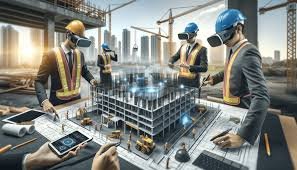Introduction to Construction Technology
In recent years, construction technology has significantly revolutionized the industry, transforming how projects are planned, executed, and managed. From groundbreaking innovations like Building Information Modeling (BIM) to using drones and artificial intelligence (AI), construction technology has allowed companies to enhance productivity, improve safety, reduce costs, and deliver sustainable projects. As the world’s demand for infrastructure and buildings continues to rise, integrating advanced technology into construction is no longer optional but necessary.
This article explores the various advancements in construction technology, discussing how these tools are reshaping the industry. We’ll dive into emerging technologies, their benefits, and their potential impact on future projects. Finally, we’ll answer common questions and provide a conclusion to help you understand the full potential of construction technology.
The Evolution of Construction Technology
Early Innovations in Construction
The construction industry has always been at the forefront of technological innovation, dating back to the invention of the wheel and early machinery like cranes and hoists. Over the years, technological advancements have played a crucial role in improving building processes, safety, and efficiency.
However, the introduction of digital technology in the 21st century has accelerated the pace of change. Software solutions and automated tools now allow for more precise planning, construction, and management, reducing human error and increasing the speed of project completion.
Current Innovations in Construction Technology
- ficant role in construction, offering predictive analytics, automating tasks, and improving decision-making processes. AI can analyze vast amounts of data through machine learning algorithms to predict project outcomes, foresee potential risks, and recommend the best course of action.
- AI can optimize resource allocation, reducing costs and waste.
- It also improves safety by predicting potential hazards and preventing accidents.
Website source: Explo
- Building Information Modeling (BIM)
One of the most significant innovations in recent years is Building Information Modeling (BIM). This digital tool allows project stakeholders to collaborate on a unified model of a building before its construction begins. With BIM, architects, engineers, and contractors can create detailed, 3D representations of buildings that provide insight into every aspect of the structure—from design to materials and functionality.
- BIM improves collaboration, as all team members work with the same updated model, preventing costly errors.
- It also allows for more accurate cost estimation and resource allocation, improving project outcomes.
Website source: Learn more about BIM technology here.
- Drones in Construction
Drones have emerged as a powerful tool in the construction industry, offering aerial site inspections and project monitoring. These uncrewed aerial vehicles (UAVs) can capture high-resolution images and videos, providing real-time data and analysis of construction sites.
- Drones help improve safety by inspecting hard-to-reach or hazardous areas.
- They enhance site management by offering a bird’s-eye view of the project, allowing for better progress tracking.
- Artificial Intelligence (AI) and Machine Learning
AI is beginning to play a signire AI applications in construction here.
- 3D Printing in Construction
3D printing technology makes construction waves by allowing companies to fabricate building materials on-site, reducing time and material waste. Large-scale 3D printers can create concrete walls, bridges, and even entire homes at a fraction of the cost and time of traditional methods.
- This technology can reduce construction time significantly.
- It promotes sustainability by using fewer materials and producing less waste.
Website source: Check out how 3D printing is used in construction here.
- Robotics in Construction
Robotic automation is transforming labor-intensive tasks on construction sites. Robots can now perform repetitive functions like bricklaying, welding, and excavation with high precision, minimizing human error and reducing costs.
- Robots can work in dangerous environments, improving worker safety.
- They also enhance productivity, completing tasks more quickly than manual labor.
Benefits of Construction Technology
The adoption of construction technology offers several advantages, including:
- Improved Efficiency: Technologies like BIM, drones, and AI streamline processes, allowing for faster and more efficient project execution.
- Cost Savings: Companies can significantly cut costs by improving resource management and reducing waste. 3D printing and robotic automation further contribute to cost-effectiveness.
- Enhanced Safety: Automation and predictive analytics help mitigate risks and improve on-site safety, protecting workers from dangerous situations.
- Sustainability: Technologies that reduce material waste, like 3D printing and AI, push the industry toward more sustainable practices.
- Better Collaboration: Tools like BIM facilitate collaboration among architects, engineers, contractors, and clients, ensuring everyone is on the same page and minimizing errors during construction.
Future Trends in Construction Technology
- Smart Construction Materials
The future of construction may see the integration of innovative materials—substances that can adapt to changing environmental conditions. These materials could respond to heat, light, or moisture, improving energy efficiency and reducing the need for frequent repairs.
- Augmented Reality (AR) and Virtual Reality (VR)**
AR and VR are gaining traction in construction for design visualization and training. These technologies allow stakeholders to experience projects virtually before construction begins, improving decision-making and identifying design flaws early on.
- AR overlays digital information in real-world environments, making site management and navigation more efficient.
- VR provides immersive training environments for workers, enhancing safety protocols and construction techniques.
- Internet of Things (IoT) in Construction
IoT technology connects devices and systems on construction sites, enabling better monitoring and control. Sensors placed on equipment and materials can provide real-time data, helping to optimize workflows, track assets, and improve safety measures.
Challenges of Construction Technology Adoption
Despite the numerous benefits, adopting construction technology is challenging. Some companies may face obstacles such as:
- High Initial Costs: Implementing new technology, such as robotics or AI, requires a significant investment, which may be a barrier for smaller firms.
- Training and Skill Gaps: The workforce must be trained to use these new tools, and some companies may need help finding skilled employees capable of handling advanced technologies.
- Data Security: With the rise of digital tools comes the risk of cyber-attacks and data breaches. Companies must prioritize data security to protect sensitive project information.
Final Thoughts
Integrating construction technology into the industry is no longer just a trend but a necessity. As infrastructure demands rise and project complexity increases, embracing technological advancements is critical to staying competitive. From BIM and AI to drones and 3D printing, construction technology offers a wealth of opportunities for companies to improve efficiency, safety, and sustainability.
By addressing the challenges of adoption and training the workforce, the industry can continue to innovate and deliver smarter, faster, and more cost-effective projects. As we progress, it will be exciting to see how emerging technologies like IoT, AR, and VR further shape the construction landscape.
Questions & Answers
Q: How does BIM improve construction projects?
A: BIM facilitates better collaboration, reduces errors, and improves cost estimation by allowing all stakeholders to work from a unified project model.
Q: What are the main benefits of using drones in construction?
A: Drones improve site safety, offer real-time monitoring, and provide valuable data for managing construction projects.
Q: How can 3D printing change the future of construction?
A: 3D printing can reduce construction time, minimize waste, and lower costs, making it a game-changer for the industry.
Q: What are the challenges of adopting new construction technology?
A: High initial costs, training requirements, and data security concerns are companies’ main challenges when adopting new technologies.



